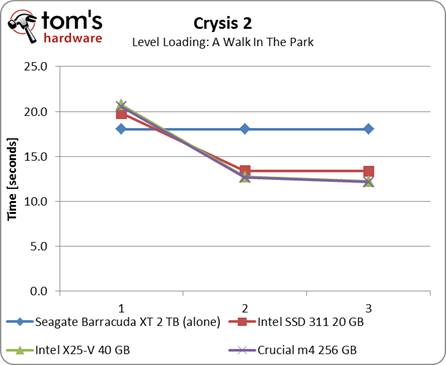The Intel Z68 Express Review: A Real Enthusiast Chipset
SSD Caching Benchmarks: Real-World
Our Photoshop benchmark slightly mirrors the results from PCMark's Memories Suite, but notice the small time difference. In a real-world environment, Intel's SSD caching strategy doesn't allow you to edit photos any faster than you would with a pure hard drive configuration.
Intel doesn't seem to cache the blocks that make up archives, perhaps assuming these are files that only get touched once as well. So, you won't see any benefit in WinRAR or WinZip.
However, virus scanning seems to enjoy a slight performance bump. While Intel ignores the files being scanned (as part of its caching algorithm), the Norton Internet Security 2011 executable is cached. In addition, virus scanners typically perform record keeping functions and scan suspicious files in a sandbox manner so as not to infect the system. This involves a small amount of writing, which could account for the better performance seen on the m4 and the SSD 311.
If ever there was a graph that visualized why you should spend $100 on 20 GB of SLC NAND instead of the same sum on 40 GB of MLC, this would be it. Intel's X25-V can only sustain sequential writes of up to 35 MB/s. This cannot keep up with the Barracuda's maximum outside-diameter data rate of 138 MB/s. So, the SSD actually slows down performance dramatically. Consider this a worst-case scenario for Smart Response Technology.
Gamers, rejoice. Level loading (one of the premiere reasons to invest in solid-state technology) sees a huge gain at the hands of Intel's caching mechanism. Of course, this makes sense: it's all read-based application data, so caching is a perfect fit. It's only a shame that it takes a second or third run to realize the benefit that you'd get immediately on a pure SSD-based implementation.
Get Tom's Hardware's best news and in-depth reviews, straight to your inbox.
Current page: SSD Caching Benchmarks: Real-World
Prev Page SSD Caching Benchmarks: PCMark Vantage Next Page Lucidlogix’s Virtu: Reclaiming Performance And Transcoding-
LuckyDucky7 The Intel 311 might be one of the weirdest products I've seen for a while.Reply
It doesn't have an impact on games and apps which are too large to be cached and 60 GB drives that blow the 311 out of the water can be had for 20 bucks more.
And as far as getting QuickSync, it's about time. Should have been done in P67 (along with USB 3.0 support and 6 x SATA III ports) is all I can say. -
acku In an ideal world, that's what we should have seen, but Lucidlogix's Virtu really makes Z68 worth it.Reply -
ghnader hsmithot Sir and madam working at intel.You make us customers look retarded.Thank you.Reply -
Olle P mayankleoboy1is this realy the platform for enthusiasts? with almost daily news of lga2011 ... its a little bit hard to get too happy with thisYes it is!Reply
I am going to buy myself a Z68 mobo and a Core i5-2500K within a few weeks.
If you buy yourself an LGA2011 based platform we can get together a month from now and compare the results!
... or rather not, since it will take at least half a year for the 2011 to become available.
Let's face it. For at least a full month from now the Z68 will be the enthusiast platform.
Then AMD's competition will arrive, and we'll see how much of an option that is. -
acku hmp_gooseWhat is this "QuickSync"? My people do not have this word …Reply
http://www.tomshardware.com/reviews/sandy-bridge-core-i7-2600k-core-i5-2500k,2833-4.html -
ta152h A good comparison would have been striping hard disks to compare against caching with EEPROMs. You'd have more capacity, a lot more, and wouldn't have a technology that dies after a certain amount of writes, which is dubious to use for something that's being used as a cache, and written on rather consistently.Reply
Performance of Raid 0 would be higher than a single disk, and you'd be increasing performance without a loss in capacity (per dollar). Or, if you wanted the same capacity. you could get higher performance disks, and compare them that way.
If I want to spend an extra $100 to make my computer faster, will it? Duh, of course. That's all this article is saying. Is it the best way to spend that $100? Well, that much isn't clear at all. It wasn't compared with much of anything else. Two high capacity disks striped, and two higher performance disks (but lower capacity) striped, versus one disk and EEPROMs. All should be the same cost. It's more useful information. You'd have three fundamental choices - huge capacity, high "Winchester" performance, and low capacity with EEPROM caching. You could do a search on the capacity trade-offs pretty easily, but the performance difference between this caching and a high performance magnetic disk in RAID 0 is much less clear. Obviously, the hard disks would win a lot of tests, and could be a better buy for a lot of people.
It is worth looking at. -
Olle P Another little detail:Reply
Larsen Creek was the work name for Intel's SSD.
The final name now in use is Larson Creek, as can be easily read in the picture. -
flong Hey, did I read this right, the theoretical maximum of the 2600K and 2500k chips is 5.7 ghtz???? Has anyone ever got a cpu that high? The most Ive read about is 5.0 ghtz and that was with water cooling. So does 5.7 ghtz exist?Reply -
My GoD!Reply
Intels output is capped at 1920x1200? Below my native res! I've been forced to put my buy on hold...
What were they thinking?






